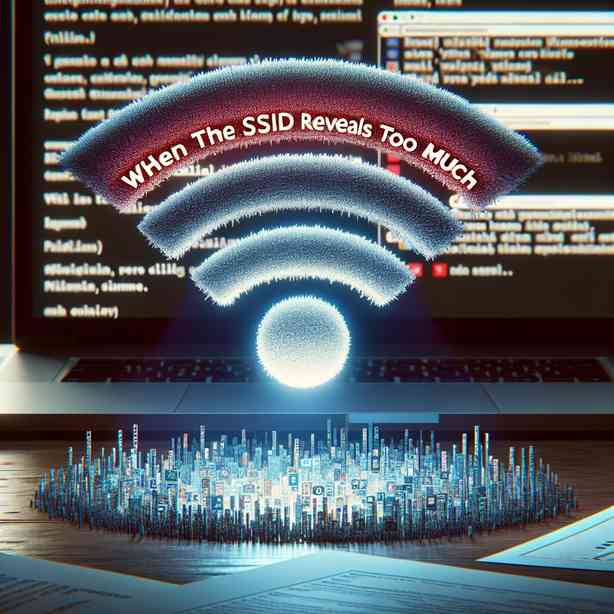
In today’s interconnected world, the wireless communication network has become a critical part of our everyday lives. From homes to offices, Wi-Fi networks are ubiquitous, providing convenience and connectivity. However, this convenience comes with its own set of risks, particularly when it comes to how we name our wireless networks. The SSID, or Service Set Identifier, is the name of a Wi-Fi network, and it can reveal more information than one might expect. Understanding the implications of SSID naming is essential for enhancing your network’s security and safeguarding sensitive information.
When selecting an SSID, many individuals may opt for names that are personal, humorous, or reflective of their interests. While these names can add a touch of personality to a network, they can inadvertently expose details that may compromise one’s privacy and security. For instance, using a family name, the name of a pet, or a specific location can lead to easy identification by anyone scanning for networks. If you live in a neighborhood where many people use the same internet service provider, an SSID that reveals personal details about you or your family could easily become a target for potential intruders.
Moreover, certain SSIDs can inadvertently broadcast information about the type of devices connected to a network. For example, an SSID like “John’s Smart Home” can indicate to an outsider that your home is equipped with smart devices, which may attract hackers looking to exploit vulnerabilities in home automation technologies. Such information, although seemingly innocuous, can be the first step for attackers to craft targeted phishing schemes or attempt unauthorized access to your devices.
In essence, the personal touch that many users want to add to their SSID can backfire significantly. Instead of using something easily identifiable, one should consider using a random combination of letters and numbers. This practice mitigates the risk of unwanted attention from those who may be looking for potential targets. By opting for non-descriptive SSIDs, network owners fortify their defenses against unauthorized access and maintain a level of anonymity that could prove crucial in preventing security breaches.
We also need to acknowledge the environment where the Wi-Fi network operates. Public places, such as cafes, libraries, and even some parks, often have open networks with visible SSIDs. These networks are particularly susceptible to various types of attacks, including man-in-the-middle attacks. Cybercriminals can create fake access points with SSIDs that closely resemble legitimate ones, tricking unsuspecting users into connecting. When users unknowingly connect to these rogue networks, they may inadvertently provide sensitive information, such as passwords or financial details, to the attacker.
To illustrate this point further, consider a café with a Wi-Fi network named “Free Café Wi-Fi.” This name is straightforward and inviting, but it also raises questions about security. If an outsider sets up a rogue network called “Free Café Wi-Fi 2,” they could easily convince customers to connect to their network instead, posing a significant risk to personal data. Understanding the nuances of naming conventions in public Wi-Fi networks can help users remain vigilant and make informed decisions about their connectivity options.
Security doesn’t just end with the choice of SSID; it extends to the entire network configuration. Ensuring that a network is secured with a strong password is crucial. Even if your SSID does not disclose much information, a weak password can allow unauthorized users to gain access to your network. This underscores the importance of implementing additional security measures, like WPA3 encryption, which enhances the security of communication over wireless networks.
Transitioning to stronger forms of authentication and utilizing firewalls can further increase network security. Each layer of security protects against unauthorized access and contributes to a more secure wireless environment. Education plays a pivotal role as well; users must remain informed about potential threats and how to avoid them effectively.
Furthermore, the implications of SSID naming extend beyond individual home networks. Businesses, in particular, need to be acutely aware of the information that their network’s name might convey. An SSID that includes the name of the business, such as “Joe’s Bakery Free Wi-Fi,” can inadvertently attract unwanted attention from cybercriminals targeting the business’s customer base. Instead, using a neutral SSID can help safeguard not just the business’s connected devices but also the personal devices of customers who may connect to the network.
It is also advisable for businesses to implement guest networks that are separate from their primary network. In this way, customers can access the internet without being granted access to the internal network that contains sensitive business information. A separate guest network with a secure password can shield the internal resources while still providing convenience for patrons. This practice not only enhances security but also demonstrates a commitment to customer safety and privacy.
In conclusion, while the SSID may seem like a trivial aspect of creating a Wi-Fi network, it plays a significant role in the overall security posture of both personal and business networks. Individuals and businesses alike should be mindful of the implications behind their chosen SSIDs. Opting for non-descriptive names, utilizing strong passwords, and implementing robust security measures can make a significant difference in protecting sensitive information. By looking beyond the surface of networking choices, users can safeguard their data and enhance their digital privacy in an increasingly interconnected world. Through awareness and proactive measures, we can enjoy the benefits of wireless technology without compromising our security.


